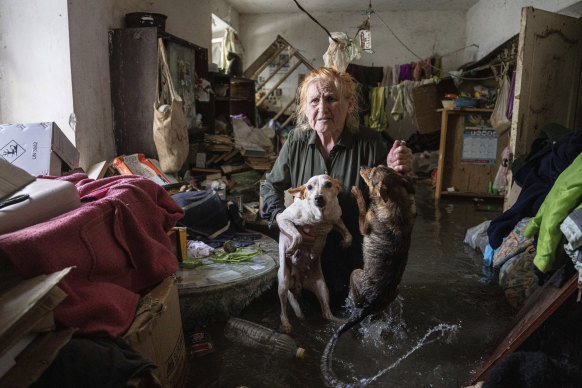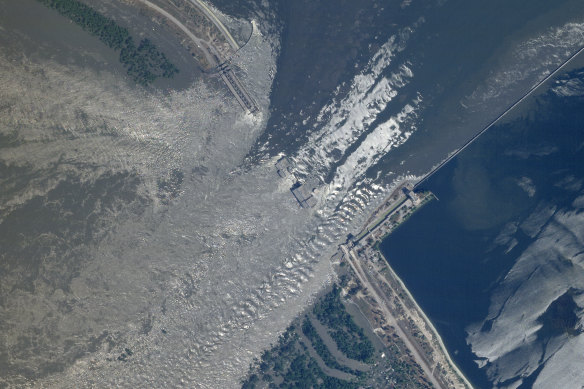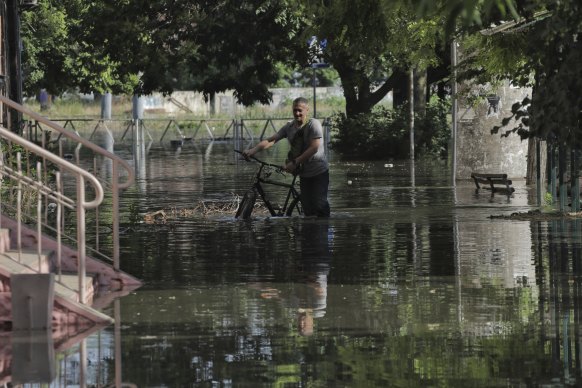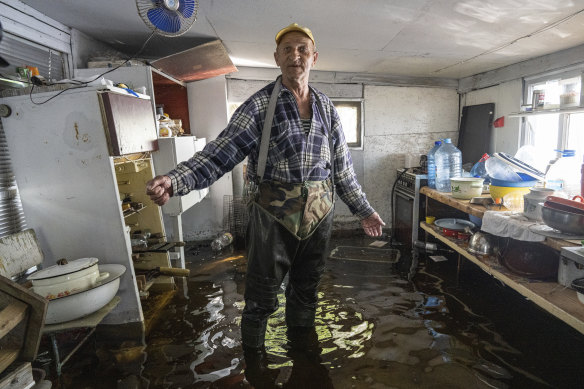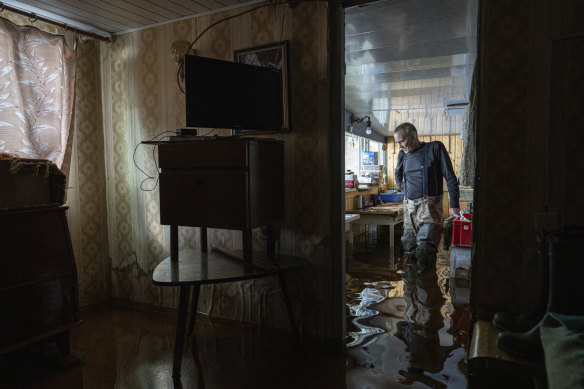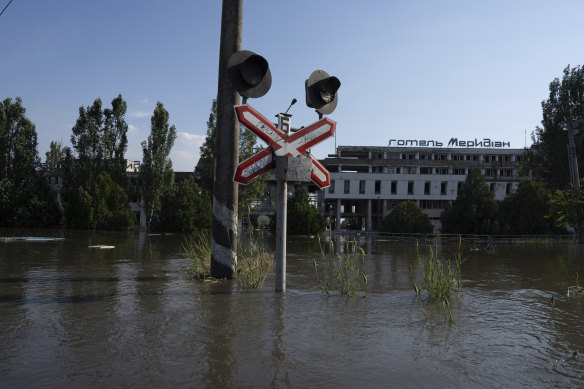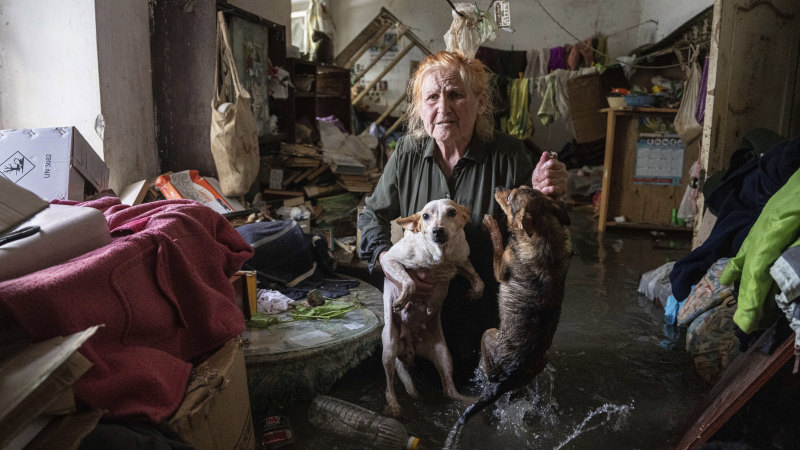
Ukrainian villagers flee after Nova Kakhovka dam floods war zone
June 6, 2023Save articles for later
Add articles to your saved list and come back to them any time.
Kherson: A torrent of water burst through a massive dam on the Dnipro River that separates Russian and Ukrainian forces in southern Ukraine on Tuesday, flooding the war zone, forcing villagers to flee and prompting finger-pointing from both sides.
Ukraine said Russia had committed a deliberate war crime in blowing up the Soviet-era Nova Kakhovka dam. The Kremlin blamed Ukraine, saying it was trying to distract from the launch of a major counteroffensive Moscow says is faltering. Some Russian-installed officials said the dam had collapsed on its own.
Local resident Tetiana holds her pets, Tsatsa and Chunya, as she stands inside her flooded house after the Kakhovka dam was breached in Kherson.Credit: AP
Neither side offered immediate public evidence of who was to blame. The Geneva Conventions explicitly ban targeting dams in war because of the danger to civilians.
US intelligence pointed to Russia being behind the destruction, NBC News said.
Hundreds of people were evacuated from settlements along the southern stretch of Ukraine’s Dnipro river as water submerged streets, town squares and homes.
Lidia Zubova, 67, was waiting for a train out of the city of Kherson in Ukrainian government-controlled territory after abandoning her inundated village of Antonivka.
This satellite image shows an overview of the damage to the Kakhovka dam on Tuesday.Credit: Planet Labs PBC via AP
“Our local school and stadium downtown were flooded … The road was completely flooded, our bus got stuck,” she said.
Ukrainian police released video of an officer carrying an elderly woman to safety and others rescuing dogs in villages being evacuated as the waters rose.
Interior Minister Ihor Klymenko accused Russia of shelling areas from which where people were being evacuated and said two police officers were wounded.
A man pushes his bicycle along a flooded street in Kherson.Credit: AP
On the Russian-controlled bank of the Dnipro, the Moscow-installed mayor of Nova Kakhovka said water levels had risen to 11 metres. He did not say how high water levels were before the dam burst.
Residents reached by telephone there said that some locals had decided to stay despite being ordered out.
“They say they are ready to shoot without warning,” said one man, Hlib, describing encounters with Russian troops.
“If you come a metre closer than allowed, they immediately start yelling obscenities.”
Another resident, Yevheniya, said the water was up to the knees of the Russian soldiers walking the main street in high rubber boots.
“If you try to go somewhere they don’t allow, they immediately point their machine guns at you,” she said. “More and more water is coming every hour. It’s very dirty.”
Mykola Gurzhiy, 74, a local fisherman, in the kitchen of his flooded house on the island of Kakhovka, on the Dnipro river near Lysohirka.Credit: AP
The Kazkova Dibrova zoo on the Russian-held riverbank was completely flooded and all 300 animals were dead, a representative said via the zoo’s Facebook account.
The small town of Oleshky, on the Russian-controlled bank of the Dnipro, was almost completely flooded, a Russian-appointed official said.
“Evacuation … is possible only using special equipment,” Andrei Alexeyenko, chairman of the Russian-appointed government of Ukraine’s Kherson province, said on Telegram.
The dam supplies water to a wide area of southern Ukrainian farmland, including the Russian-occupied Crimean peninsula, as well water to cool the Russian-held Zaporizhzhia nuclear plant.
The vast reservoir behind the dam is one of the main geographic features of southern Ukraine, 240 km (150 miles) long and up to 23 km (14 miles) wide.
An expanse of countryside fans out in the flood plain below, with low-lying villages on the Russian-held southern bank particularly vulnerable.
Possible humanitarian disaster
The dam’s destruction threatened a new humanitarian disaster in the centre of the war zone and transformed front lines just as Ukraine prepares a long-awaited counteroffensive to drive Russian troops from its territory.
Russia has controlled the dam since early in its 15-month-old invasion, although Ukrainian forces recaptured the Dnipro’s northern bank last year. Both sides had long accused the other of plotting to destroy the dam.
“Russian terrorists. The destruction of the Kakhovka hydroelectric power plant dam only confirms for the whole world that they must be expelled from every corner of Ukrainian land,” President Volodymyr Zelensky wrote on the Telegram messaging app.
Ihor Medyunov stands in his home near Lysohirka.Credit: AP
Ukraine also called Russia a “terrorist state” at the top UN court as hearings began in a case over Moscow’s backing of pro-Russian separatists blamed for shooting down Malaysian Airlines flight MH17 over eastern Ukraine in 2014.
NATO Secretary-General Jens Stoltenberg called the dam’s destruction “an outrageous act, which demonstrates once again the brutality of Russia’s war in Ukraine”.
UN Secretary-General Antonio Guterres said the United Nations had no independent information on how the dam was breached, describing it as “another devastating consequence” of Russia’s invasion.
The UN Security Council was due to meet later on Tuesday (local time) at the request of both Russia and Ukraine.
Ukraine accused Russia of an “ecological and technological act of terrorism” while Russia cast it as an “act of sabotage carried out by Ukraine”, according to the requests seen by Reuters.
The streets of Kherson on Tuesday.Credit: AP
Kremlin spokesman Dmitry Peskov also blamed “deliberate sabotage by the Ukrainian side”.
Russian-installed officials had earlier given conflicting accounts, some saying the dam had been hit by Ukrainian missiles overnight, others that it had collapsed on its own due to earlier damage.
The UN nuclear watchdog said the Zaporizhzhia power plant, upriver on the reservoir’s Russian-held bank, should have enough water to cool its reactors for “some months” from a separate pond, even as the huge reservoir drains out.
Video showed water surging through the remains of the dam, which is 30 metres tall and 3.2 kilometres long.
Some 22,000 people living across 14 settlements in the Kherson region are at risk of flooding, Russia’s RIA news agency quoted the Moscow-installed head of the region as saying.
Reuters
Get a note directly from our foreign correspondents on what’s making headlines around the world. Sign up for the weekly What in the World newsletter here.
Most Viewed in World
From our partners
Source: Read Full Article

